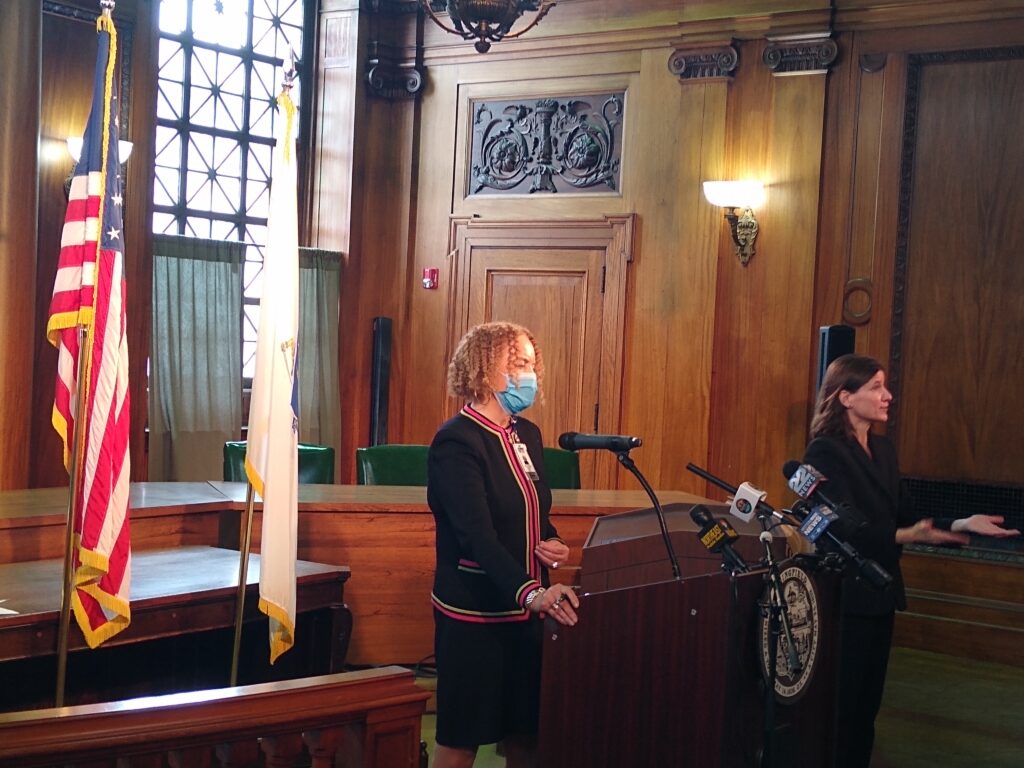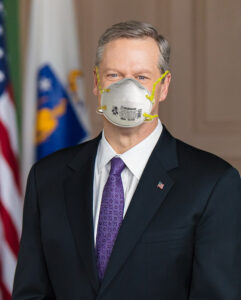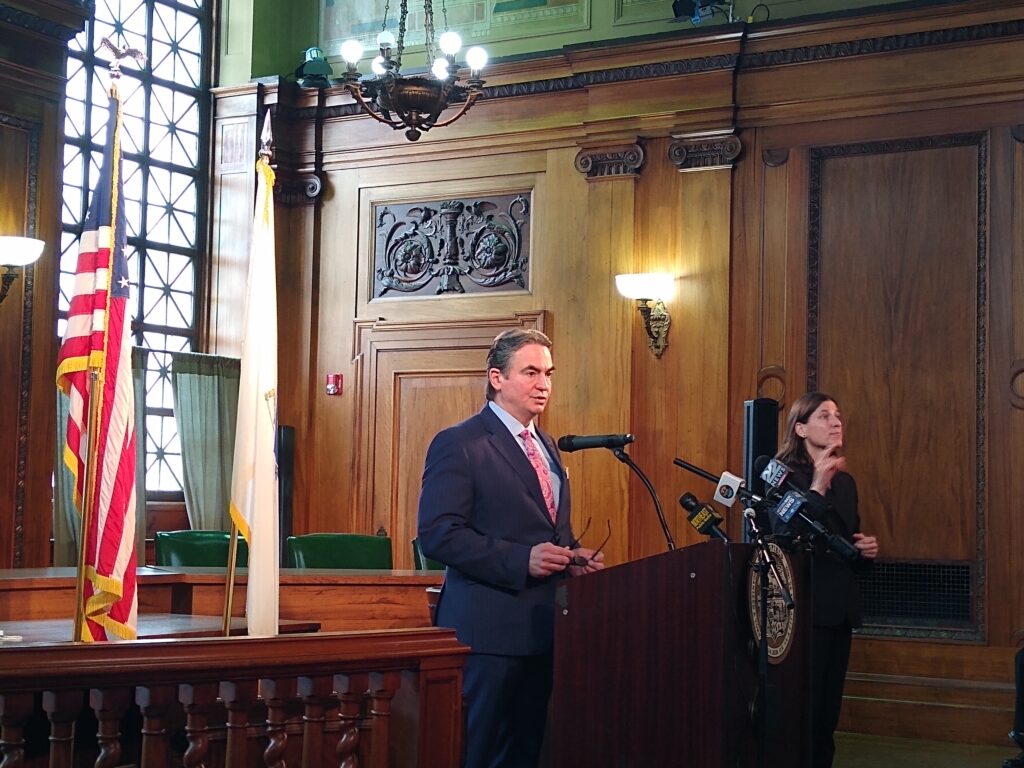Lurch to the Future? Springfield Finding Its COVID Footing…
UPDATED 4/21/20 3:46PM: A prior version of this post, and others, had misspelled the Police Commissioner’s name. It is Clapprood, not Claprood.

Alone together at the podium (aside from the sign language interpreter). HHS Commissioner Helen Caulton-Harris briefs the press. (WMP&I)
SPRINGFIELD—While the final decisions will be left to Governor Charlie Baker, it does appear that Western Massachusetts and its largest city are setting the stage for what’s next in the era of COVID-19. The regions hospitals are not overwhelmed. While testing capacity is inhibited by supply limitations, Springfield has begun implementing test and trace protocols necessary to reopen the economy.
This was the impression medical and public health officials presented at the city’s weekly briefing. Punctuated by Mayor Domenic Sarno’s “emotional” addenda to comments from department heads and hospital administrators, the update painted an upbeat picture about the city’s response. Operations have continued through the outbreak and hospitalizations are waning. Though it was not without touches of controversy leftover from last week or warnings about lifting social distancing too soon.
Springfield has become an epicenter of COVID-19 infections in Hampden County with 797 cases, about a third of the county’s overall cases. The growth in testing will be critical to curtailing spread and providing a safe environment reopen the economy.
“We have to be able to show that we can isolate potential hotspot areas,” Sarno said.
The briefing took place in former Aldermanic chamber in City Hall, a common mayoral presser spot. What was atypical—well, pre-COVID atypical—was official sitting, masked, in socially distant chairs instead of framing hizzoner.

Dr. Mark Keroack unmasked. (via Baystate.org)
From the perspective of the 413’s hospitals, however, the situation has stabilized. The President & CEO of Baystate Health Systems Dr. Mark Keroack and Mercy Medical Center’s Chief Medical Officer Dr. Robert Roose both said their facilities have adequate capacity to handle COVID-19 patients.
“This is a trend that has been seen across all the hospitals in Western Mass,” Keroack said.
Representatives from both hospitals also wanted to assure the public that their facilities could manage regular healthcare need, too. People should not risk greater health consequences for fear of COVID-19.
Both doctors said their hospitals were triaging emergency rooms and segregating ward to keep all patients safe. Through training, restructuring and daring efforts to obtain person protective equipment (PPE), both also were also equipped to handle COVID-19 and non-COVID-19 patients alike.
“You do not have to delay important evaluations or provider visits if you are in need of follow up. You do not have to avoid coming to the ER if you get suddenly ill,” Roose said. “As a physician, that is one of my biggest fears right now,” he said people’s reluctance to seek medical care.

Dr. Robert Roose, also unmasked. (via mercycares.com)
The 413’s stabilization is not atypical for Massachusetts hospitals, but it does seem more pronounced here. Keroack suggested the risk had been lower here and thus no field hospital was requested at the MassMutual Center.
During Q&A, the doctors suggested that Western Massachusetts benefited from the pattern of spread. The region’s relative lack of density was a factor, but patterns of traffic from elsewhere did not seed the virus as deeply or as early here, compared to other parts of the commonwealth.
But both also emphasized that now was not the time ease off social distancing, lest a greater outbreak occurs.
Despite the optimism from the hospitals, the city is still dealing with the spread in its own borders. A map the city compiled showed no area of the city was spared from infection. However, the red dots representing infection—the maps lacked streets to protect privacy—appeared more frequently in the city’s older, more urban quarters.
Health & Human Services Commissioner Helen Caulton-Harris said density was a pattern, but she pointed to specific issues such as multi-generational homes and the higher likelihood residents in those areas were essential workers.
She said her department did know the disease progression among the increased case and whether they could later tax the health care system. However, as part of the city’s contact and trace program, HHS was collecting symptom data from those it contacted.

The Governor has leaned into testing & tracing early. (created via wikipedia & Google image searches)
That test and trace program, which Governor Baker has executed as a statewide effort, has encountered other problems. Though, Caulton-Harris was sanguine about its efforts and people’s responsiveness.
Some COVID-19 patients and their contacts have refused to provide their own contacts. Caulton-Harris emphasized that this virus was not like sexually-transmitted infections and people should not feel ashamed or responsible for possibly infecting others.
“Overall, we’ve had excellent cooperation, however, again I think individuals are very private and they feel guilty. They feel that they have inflicted this virus on others,” she said.
“This virus is no one’s fault,” Caulton-Harris emphasized.
While like all states and municipalities, absent Congressional action, Springfield faces a fiscal crisis from the decline in revenue the novel coronavirus has caused. However, city operations have adapted. For example, the city now had its own stock of PPE as well as infrared thermometers to take employees temperature.
School Superintendent Daniel Warwick said the meals program was going well. Warwick did know if school would return on May 4. Though, he indicated a preference for some return before summer to assess whether educators must make adjustments to curricula upended by the outbreak. Though on Tuesday, Baker cancelled the remainder of the school year.
Fire Commissioner B.J. Calvi said his department had only four firefighters out due to COVID-19 infections and/or quarantines. Police Commissioner Cheryl Clapprood said only 10 of her officers were sidelined—another 11 have returned from recovering or quarantine. Public Works czar Chris Cignoli said his department was shifting schedules to keep employees at greater risk of a life-threatening COVID-19 infections away from riskier work. Some work like yard waste collection and sidewalk construction were delayed, but operations were mostly normal.
Indeed, Mayor Sarno noted City Hall’s adaptation to the outbreak to pan the courts’ supposed failure to process criminal proceedings as efficiently and expeditiously. He also trashed the release of some offenders and those awaiting trial.

How Clapprood! (via YouTube/WGBY)
Earlier Clapprood had observed that, after an lull in crime at the dawn of the lockdown, police calls and violence have gone up. She did not explicitly say this contributed to her controversial decision to reinstate officers who are awaiting trial for perjury. She did emphasize Monday that the officers had not been convicted.
Rather, Clapprood cited the shooting last Friday that left one man dead. She also suggested early releases and the relative closure of the courts had contributed to the increase in calls.
“We’re out here every day, every night,” Sarno said. “But I don’t understand certain institutions that are not open that play a pivotal role,” he continued reference the courts. “There are ways you can open.”
Massachusetts courts are nominally open but functioning with highly reduced schedules. The Hampden County courthouse has been closed three times due to COVID-19 flare-ups among staff.
However, Sarno indicated he had not raised the impact of courts’ limited operations on policing in Springfield with court officials. Nor had he asked Hampden District Attorney Anthony Gulluni for help.
“I shouldn’t have to!” he exclaimed, later adding, “I’m sure they’ll hear my message again.”
Nor did he confirm raising with the issue with the governor during their many conversations. Sarno later added that he does often speaks with Judge John Payne, the First Justice of Springfield District Court.
Whatever the city’s case numbers, the next question will be where they are flaring up.
Nursing homes and long care facilities remain hotspots. Testing the city’s transient populations remain a challenge.
While Springfield erected a tent to serve homeless COVID-19 patients during the outbreak, tests have been scarce. The city will begin testing this week—but only after US Representative Richard Neal intervened to obtain testing kits. Boston and Worcester are already testing their homeless populations.
“I believe there is a regional disparity,” Caulton-Harris said of testing the homeless.
The Department of Public Health did not return a request for comment about such disparities.
For now, Springfield seems to have caught a relative break. The city is functioning. If residents hold on and suffer restrictions a bit longer, Springfield and region could be prepared when all of Massachusetts is ready to reopen.
